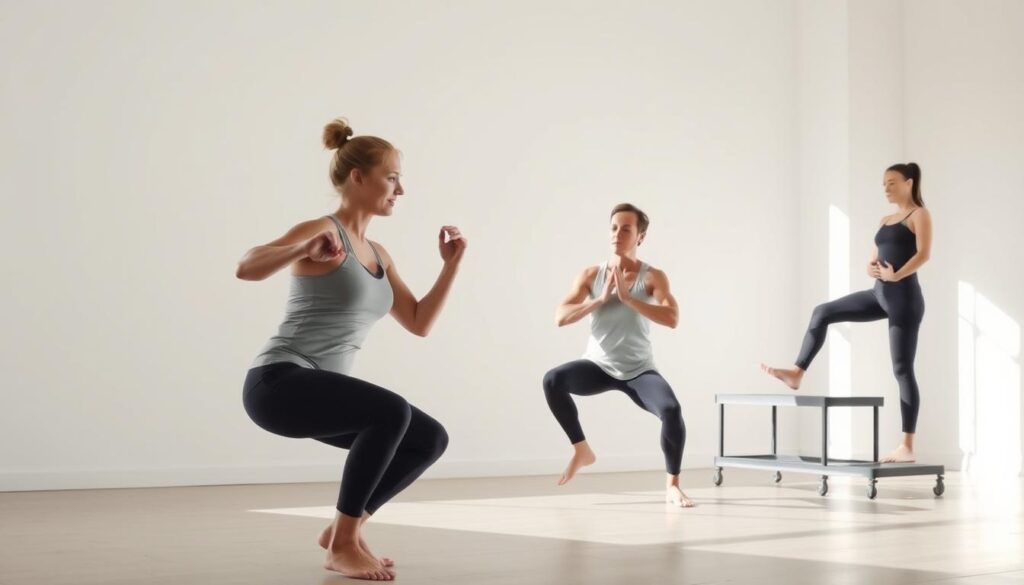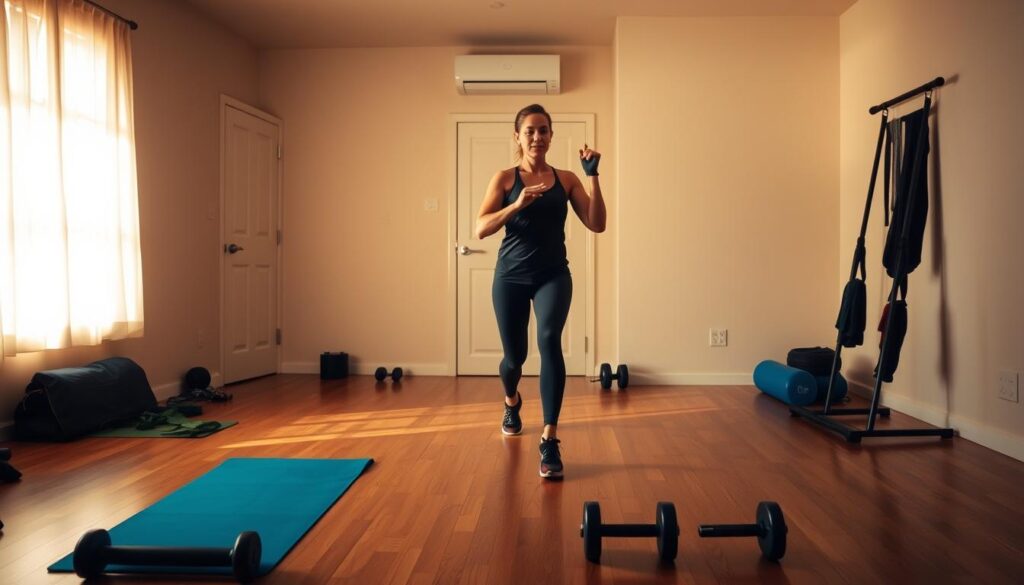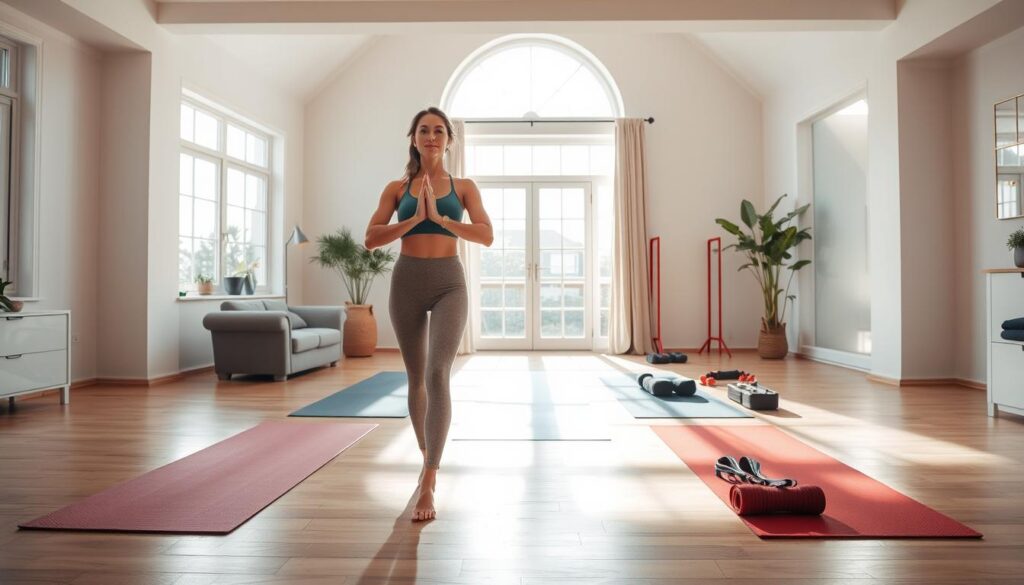Remember that moment when you felt exhausted after a workout, not from effort but from joint pain? Many fitness journeys hit roadblocks when high-impact exercises strain knees, hips, or shoulders. What if you could build strength and stamina without sacrificing comfort or risking injury?
Modern fitness isn’t about pushing through pain. It’s about working smarter, not harder. Gentle routines can still torch calories, sculpt muscles, and boost heart health. Imagine flowing through movements that leave you energized rather than drained—right in your living space.
These exercises blend cardio bursts with strength-building holds. Think controlled lunges paired with arm raises, or stability-focused planks that fire up your core. Every motion serves a purpose: improving posture, enhancing balance, and building lean muscle. Best of all? No equipment needed—just your body and determination.
Key Takeaways
- Joint-friendly routines deliver cardio and strength benefits without strain
- Bodyweight exercises engage multiple muscle groups simultaneously
- Short sessions (20 minutes) can yield significant fitness improvements
- Proper form enhances results more than high-impact movements
- Home-based workouts eliminate gym fees and commute time
- Core stability work supports better posture and functional movement
Introduction to Home-Based Low-Impact Workouts
Contrary to popular belief, low-impact routines aren’t synonymous with low intensity. Research confirms these exercises can elevate heart rates and build muscle without pounding pavement or stressing joints. A study in the Journal of Strength and Conditioning Research found that full-body circuits combining cardio and resistance training match traditional workouts for endurance gains.
Unlike high-impact methods involving jumps or rapid direction changes, these low-impact exercises prioritize controlled motions. You maintain intensity through sustained muscle engagement rather than momentum. Think slow squats with overhead presses instead of burpees—both burn calories, but one protects cartilage and tendons.
Home-based workouts remove common obstacles like crowded gyms or commute hassles. Customizable routines fit around your schedule, whether you have 15 minutes or an hour. Need modifications? Swap standing moves for seated versions or adjust range of motion to match your mobility.
The science is clear: strategic movement patterns deliver cardiovascular benefits while minimizing wear-and-tear. This approach lets you stay consistent—a critical factor for long-term fitness success. Your living room becomes a lab for building strength safely, one deliberate rep at a time.
Benefits and Considerations for Low-Impact Exercises
Imagine a workout that strengthens your body without punishing your joints. Gentle movements can deliver remarkable results when performed consistently. Let’s explore why these routines work and how to practice them safely.
Key Health and Fitness Benefits
Low-impact exercises protect cartilage while building muscle endurance. Studies show they improve bone density by 12% over six months compared to sedentary habits. Controlled motions also sharpen balance—critical for preventing falls as we age.
| Benefit | Low-Impact | High-Impact |
|---|---|---|
| Joint Stress | Minimal | High |
| Calorie Burn | Moderate | Intense |
| Injury Risk | Low | Moderate |
| Mental Clarity | Improved | Variable |
These routines boost mood through steady serotonin release. Three weekly sessions can reduce stress hormones by 26%, according to Mayo Clinic research. Better sleep often follows—a hidden perk of consistent movement.
Precautions and Safety Tips
Always warm up for 5-7 minutes before starting. Cold muscles increase injury risks. Listen closely to your body: sharp pain means stop immediately, while mild discomfort signals growth.
Consult a physical therapist if you have existing joint issues. They’ll tailor movements to your strength level. Progress gradually—add resistance bands before increasing repetition counts.
Remember: health gains come from consistency, not intensity. Track improvements in balance or stamina rather than speed. Your fitness journey should empower, not exhaust.
Dynamic Warm-Up Techniques for a Successful Workout
The secret to effective workouts starts before your first rep. Proper preparation primes your body for peak performance while safeguarding against strains. Dynamic movements outperform static stretches here—they elevate heart rates gradually and mimic exercise patterns.
Essential Warm-Up Moves
Begin with cross-body arm stretches. Stand with feet wider than hips. Pull one elbow across your chest while keeping shoulders relaxed. Switch sides after 60 seconds—this boosts shoulders mobility and engages upper back muscles.
Follow with squat-to-overhead reaches. Lower into a shallow squat, then press upward while stretching arms skyward. This dual-action movement activates legs, core, and shoulder groups simultaneously.
How to Prepare Your Body Effectively
Time each exercise to 60 seconds with 30-second rests. This rhythm raises blood flow without causing fatigue. Focus on controlled movement quality over speed—precision matters more than pace.
Dynamic warm-ups increase muscle temperature by 2-3°F, enhancing flexibility. They also improve neural connections for better coordination during main workouts. Remember: cold muscles resist stretching, while warmed tissues absorb stress efficiently.
Circuit Training: How to Structure Your Home Routine
What if your workout could evolve as quickly as your schedule changes? Circuit training offers adaptable routine structures that maximize results in limited time. This method alternates between focused exercises and strategic breaks, keeping your heart rate elevated while challenging multiple muscle groups.
Designing Your Circuit with Varied Movements
Start with three circuits containing three exercises each. Choose movements targeting different areas: upper body, core, and legs. For example, pair push-ups with side planks and reverse lunges. Perform each move for 60 seconds, allowing 5-10 seconds to transition.
| Phase | Duration | Purpose |
|---|---|---|
| Work | 60 seconds | Muscle engagement |
| Transition | 5-10 seconds | Position change |
| Circuit Rest | 15-30 seconds | Quick recovery |
| Full Rest | 60 seconds | System reset |
Tips for Rest and Transition Periods
Complete each circuit twice before resting. This approach maintains intensity while preventing burnout. Use longer breaks between circuits to hydrate or adjust equipment.
Three sessions per week create sustainable progress. Short on time? Reduce circuits but maintain 60-second work intervals. Consistency trumps duration—even 15-minute routines yield benefits when performed regularly.
Full-Body Low-Impact Workouts You Can Do at Home
Ever wondered how to elevate your heart rate without pounding joints? A well-designed cardio circuit combines fluid movements with strategic timing. These routines blend strength and endurance training through continuous motion—perfect for limited spaces and busy schedules.
- Squat-to-overhead press (engages legs and shoulders)
- Alternating lateral lunges with torso twists (activates hips and core)
- Standing mountain climbers (boosts heart rate)
- Bird dog holds (strengthens back and glutes)
- Modified burpees without jumps (full-body engagement)
- Plank shoulder taps (builds core stability)
Perform each movement for 60 seconds with no rest between exercises. After completing all six, pause for one minute before repeating the circuit twice more. This 20-minute format maximizes calorie burn while protecting joints through controlled transitions.
| Phase | Duration | Focus |
|---|---|---|
| Active Work | 6 minutes | Cardio endurance |
| Rest Interval | 1 minute | Recovery |
| Total Cycles | 3 rounds | Consistent intensity |
These compound exercises challenge multiple muscle groups simultaneously. For example, lateral lunges with twists improve hip mobility while enhancing rotational strength—skills that translate to daily activities like carrying groceries.
Adjust difficulty by changing tempo: slow motions increase muscle tension, while faster paces boost cardiovascular demand. Always prioritize smooth transitions over speed to maintain proper form and reduce injury risks.
Key Low-Impact Exercises for Full-Body Training
Building total-body strength doesn’t require pounding movements or complex equipment. Strategic combinations of upper and lower body actions paired with core engagement create balanced results. These six low-impact exercises challenge multiple muscle groups while keeping joints protected.

Upper Body and Core Focused Moves
Low-impact jumping jacks maintain constant ground contact while raising arms overhead. This variation reduces joint compression but still elevates heart rates. Combine with squat-to-jab motions—lower into a bodyweight squat, then punch across your torso to activate shoulders and obliques.
Standing oblique crunches eliminate floor work while targeting abdominal muscles. Bring elbows toward opposite knees in controlled pulses. Maintain proper position by keeping feet planted and chest lifted throughout the movement.
Lower Body and Stability Enhancers
Skaters in a curtsy lunge position develop lateral strength and hip mobility. Shift weight between legs without jumping, keeping movements smooth. Pair with lateral shuffles—bend knees and step sideways to improve agility in different movement planes.
Reverse-lunge front kicks build unilateral leg power. Step backward into a lunge, then drive forward into a controlled kick. This sequence enhances balance while strengthening quads and glutes. Focus on stability through each transition for maximum benefit.
Modifying Workouts for Different Fitness Levels
Tailoring your routine to match personal capabilities transforms frustration into progress. Whether you’re recovering from injury or seeking new challenges, adaptable exercises ensure sustainable growth. Scalable routines let you control intensity while maintaining joint safety—no rigid formulas required.
Adjusting Intensity and Tempo
New to fitness? Start with 30-second intervals instead of full-minute sets. Gradually extend durations as stamina improves. For advanced practitioners, add resistance bands or light dumbbells from strength training exercises to amplify muscle engagement without compromising form.
Control pace to manage difficulty. Slower movements increase time under tension for strength gains. Faster tempos elevate heart rates for cardio benefits. One study found alternating speeds within a single session boosts metabolic burn by 18% compared to steady pacing.
- Reduce range of motion during lateral lunges if mobility feels limited
- Add isometric holds to plank variations for core stability challenges
- Increase circuit repetitions weekly to build endurance systematically
Your energy levels fluctuate daily—and that’s normal. On high-energy days, tack on an extra round. When fatigued, prioritize precision over speed. As physical therapist Dr. Elena Torres notes: “Progress isn’t linear. Consistency with self-awareness creates lasting results.”
Integrating Cardio and Strength Components
Why choose between heart-pumping cardio and muscle-building strength work when you can fuse both? Hybrid training methods maximize results by keeping your heart rate elevated while challenging major muscle groups. This approach turns everyday movements into dual-purpose tools for fitness gains.

HIIT Format Advantages
High-intensity interval training (HIIT) isn’t just for sprinters. Modified low-impact versions use timed intervals to spike cardio output. Work at 80% effort for 40 seconds, then recover for 20. Studies show this pattern burns 25% more calories than steady-paced sessions while preserving joint health.
Bodyweight exercises like plank jacks or squat presses become cardio accelerators when performed rhythmically. Your heart pumps harder as legs and arms work in unison—no jumping required. Three weekly sessions can improve VO2 max by 9% in eight weeks, per Sports Medicine research.
Bodyweight vs. Minimal Equipment Options
Start with foundational moves requiring only your bodyweight. Push-up variations and lateral lunges build strength through controlled repetitions. Once these feel manageable, introduce 5-10 lb dumbbells or resistance bands to increase muscle demand.
| Bodyweight Focus | Equipment Enhancement |
|---|---|
| Mountain climbers | Weighted vest climbs |
| Glute bridges | Hip thrusts with dumbbell |
| Bird dogs | Ankle weights for leg lifts |
Progress happens through smarter challenges—not heavier weight. Slow tempos during squats or extended plank holds create time-under-tension effects. For variety, add rotational moves like torso twists during lunges to engage oblique muscles differently.
Conclusion
Transformative fitness results don’t require high-impact strain. Consistent low-impact exercises strengthen muscles and protect joints while boosting cardio capacity. Research confirms these routines match traditional workouts for building endurance when performed 3-4 times weekly.
Home-based training eliminates barriers like gym fees or commute time. Focus on smooth movements—like controlled lunges or standing core rotations—to engage multiple muscle groups safely. Studies show measurable improvements in heart health and leg strength emerge within 8 weeks of regular practice.
Adjust intensity by altering tempo or adding resistance bands. Prioritize proper form over speed: keep knees aligned during squats, shoulders relaxed during arm movements. This approach reduces injury risks while maintaining workout effectiveness.
The true power lies in sustainability. Enjoyment drives long-term adherence more than extreme effort. Whether modifying floor exercises for limited mobility or challenging stability with single-leg balances, every movement counts toward lasting fitness gains.
